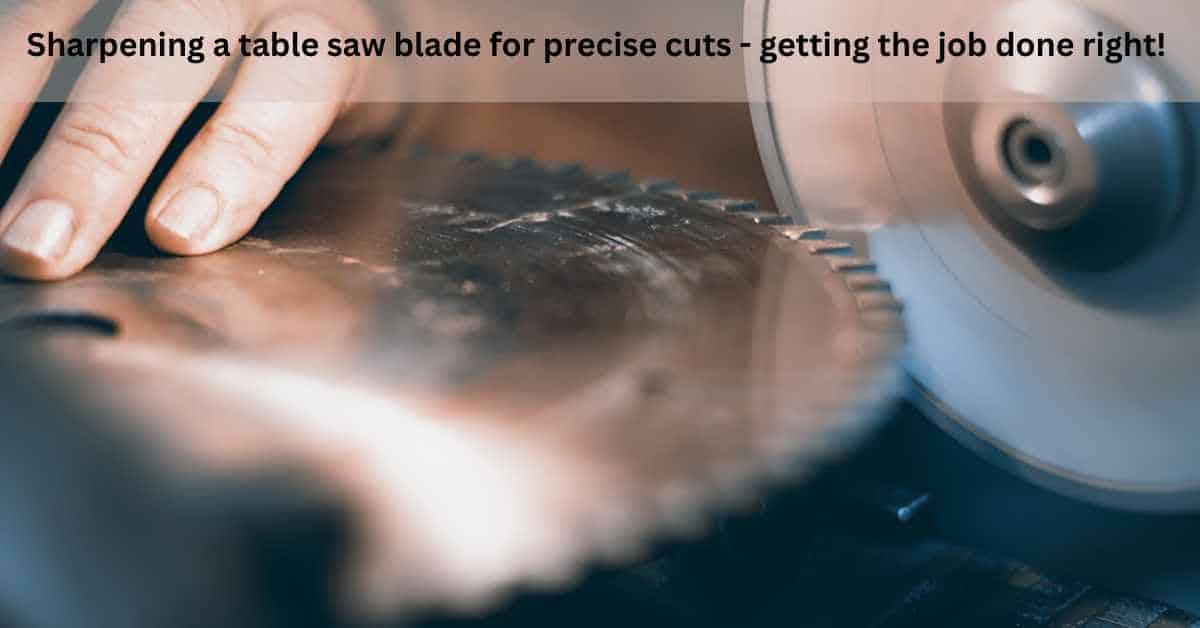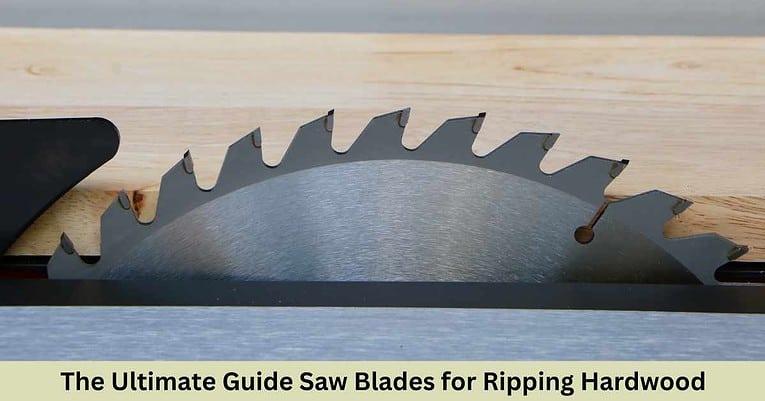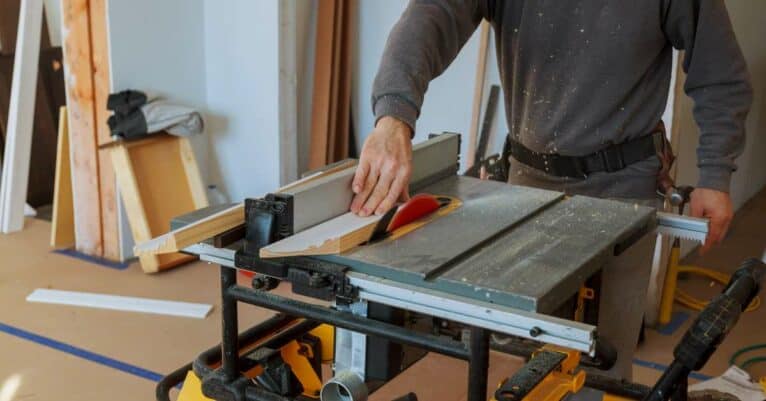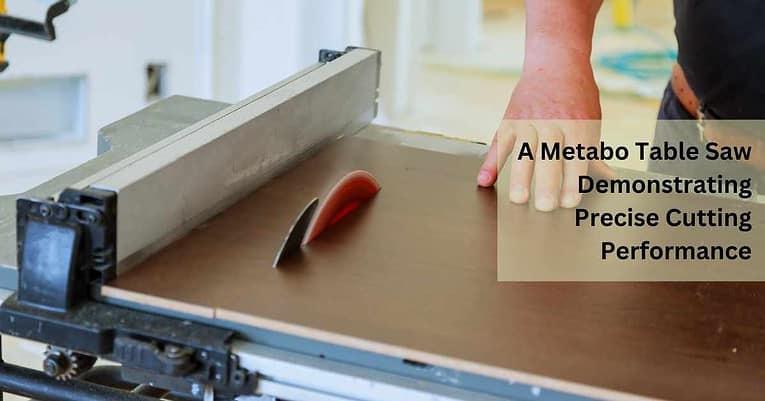How to Sharpen a Table Saw Blade: Step-by-Step Guide
How to sharpen a table saw blade?
Proper care of your table saw blade is essential for optimal performance, safety, and extending the life of both the blade and the saw. One key aspect of maintaining your blade is sharpening it, ensuring clean, precise cuts and reducing the likelihood of accidents caused by dull or damaged blades. Moreover, a sharp blade minimizes strain on the saw motor, prolonging its life and preventing potential damage.
In this guide, we’ll walk you through the process of sharpening a table saw blade step by step. We’ll discuss everything from safety precautions and inspecting the blade to the actual sharpening process and reinstalling the blade. By adhering to these instructions, you’ll maintain a sharp table saw blade, improve your project outcomes, and extend the life of your equipment.
Safety Precautions
Before beginning the process of sharpening a table saw blade, it’s crucial to follow proper safety precautions. These measures will help prevent accidents and ensure a smooth, efficient sharpening process.
Disconnecting power source
Always disconnect the table saw from its power source before starting any maintenance work. Unplugging the saw ensures that it won’t accidentally start while you’re working on the blade. If your table saw is wired directly into the electrical system, switch off the breaker to cut off power.
Wearing appropriate protective gear
To protect yourself during the sharpening process, wear the necessary safety gear, including:
a. Safety goggles: Shield your eyes from debris and dust.
b. Gloves: Wear cut-resistant gloves to protect your hands from sharp blade edges and reduce the risk of injury.
c. Hearing protection: If using power tools for sharpening, consider wearing earplugs or earmuffs to minimize noise exposure.
Securing the work area
Ensure that your workspace is clean, well-lit, and free from distractions. Clear any clutter or debris that could cause tripping hazards or interfere with the sharpening process. Additionally, use a stable workbench or table with sufficient space to comfortably work on your blade.
You may also like:
- Learn How to Change the Table Saw Blade
- SawStop Contractor Saw Review
- Rip Through Hardwood with Ease: Our 10 Best Table Saw Blades
- Easy Steps: Changing a Table Saw Blade
Inspecting the Blade

Before sharpening your table saw blade, it is essential to inspect it thoroughly. This involves identifying the blade type and assessing its condition to determine if sharpening is appropriate or if a replacement is necessary.
Identifying blade type
Understanding the type of blade you are working with is crucial for proper sharpening. There are three common types of table saw blades:
1. Ripping blades: These blades are designed for cutting along the grain of wood (ripping). They typically have fewer teeth (24-40) and larger gullets to remove material efficiently.
2. Crosscut blades: Crosscut blades are intended for cutting across the grain of wood. They have more teeth (60-80) and smaller gullets, providing a smoother, cleaner cut.
3. Combination blades: Combination blades offer the versatility of both ripping and crosscutting. They usually have 40-50 teeth arranged in groups, with a mix of larger and smaller gullets for efficient material removal and smooth cuts.
Assessing blade condition
Inspect your blade for any signs of damage or wear that could affect its performance or make sharpening difficult:
Chipped or broken teeth: Look for teeth that are visibly chipped, cracked, or broken. While minor chips can be fixed during sharpening, severely damaged teeth may require professional repair or blade replacement.
Warping or bending: Examine the blade for any signs of warping or bending. A warped blade cannot be sharpened effectively and should be replaced.
Excessive wear or damage: Check the blade for signs of extreme wear, such as missing carbide tips, deep scratches, or excessive rust. These issues can make sharpening ineffective or impossible, necessitating a new blade.
Removing the Blade
To remove the table saw blade for sharpening, follow these steps:
1. Engage the blade lock according to your saw’s instructions, or use a block of wood to secure the blade.
2. Use a wrench to turn the arbor nut counterclockwise, then remove it and any other components.
3. Carefully lift the blade from the saw, holding it by the sides to avoid contact with sharp teeth.
Cleaning the Blade
Cleaning the blade is an essential step before sharpening, as it ensures optimal results and makes the process easier. Begin by soaking the blade in a commercial blade cleaner or a solution of warm water and mild detergent for approximately 15-30 minutes to loosen any buildup of resin, pitch, and other debris. After soaking, gently scrub the blade’s teeth and surfaces with a brass-bristle brush, as brass bristles are less likely to damage the carbide teeth than steel bristles. Make sure to remove all remaining debris, as this will help you achieve a more effective and precise sharpening. Once the blade is thoroughly cleaned, rinse it with clean water to remove any residual cleaner or debris. Lastly, dry the blade completely using a clean cloth or air compressor, ensuring that it is moisture-free to prevent rusting before proceeding to the sharpening process.
Sharpening the Blade
To sharpen your table saw blade, follow these steps:
1. Select appropriate sharpening tools: Choose the right tool for your blade, such as a diamond file for carbide-tipped blades, a blade sharpening jig for consistent sharpening angles, or a whetstone or oilstone for steel blades.
2. Sharpening the teeth: Start by aligning the tooth angle with the sharpening tool to maintain the original bevel. Apply consistent pressure and even strokes to each tooth, ensuring that you remove an equal amount of material from each tooth. Be patient and maintain focus during this process, as it requires precision.
3. Repeat for all teeth: Work your way around the entire blade, sharpening each tooth while maintaining consistent pressure and strokes. This will help ensure an even sharpness across all teeth.
4. Balancing the blade: After sharpening, it’s important to check the blade’s balance using a blade balancer. An unbalanced blade can cause vibrations and reduce cutting accuracy. Place the blade on the balancer, and if it tilts to one side, gently file the heavier side until it is balanced. Once the blade is balanced, you can reinstall it onto your table saw.
Reinstalling the Blade
After sharpening and balancing the blade, follow these steps to reinstall it onto your table saw:
Placing blade onto the arbor: Carefully position the blade onto the arbor, making sure that the teeth are facing in the direction of rotation. Ensure that the blade is properly seated and aligned.
Tightening blade arbor nut: Replace any components you removed earlier, such as the washer, and then thread the arbor nut onto the arbor. Tighten the nut clockwise (righty tighty) using a wrench. If your saw has a blade lock, engage it to secure the blade during tightening. Otherwise, use a block of wood to hold the blade in place.
Reconnecting power source and testing: After reinstalling the blade, reconnect the power source or switch on the breaker if your saw is wired directly. Before using the saw, test it by making a few test cuts on scrap material to ensure that the blade is functioning properly and providing clean, smooth cuts.
Maintenance Tips
To prolong the life of your table saw blades and ensure optimal performance, follow these maintenance tips:
Regular cleaning and inspection: Periodically clean your blades with a blade cleaner or a mild detergent solution to remove resin, pitch, and debris buildup. Regularly inspect the blade for signs of wear, damage, or dullness, and sharpen or replace as needed.
Proper storage of blades: Store your table saw blades in a safe, dry location to prevent rust and damage. Consider using blade storage racks, cases, or wall-mounted holders to keep them organized and protected.
Knowing when to replace blades: Despite proper maintenance, blades will eventually need to be replaced. Be aware of the signs indicating that a blade is beyond repair, such as missing carbide tips, severe warping, or extensive damage. Replace blades when necessary to maintain the performance and safety of your table saw.
Recommended: How to maintain a table saw
How to Sharpen a Table Saw Blade on the Table Saw?
Conclusion
In summary, sharpening your table saw blade is a crucial aspect of tool maintenance that ensures optimal performance, safety, and longevity of both the blade and the saw. The sharpening process involves inspecting the blade, removing and cleaning it, selecting the appropriate sharpening tools, sharpening each tooth, balancing the blade, and reinstalling it onto the saw. Emphasizing safety and maintenance throughout this process is of paramount importance to prevent accidents and protect your equipment.
By following these guidelines and regularly caring for your table saw blades, you can effectively extend their life and improve the quality of your woodworking projects. Remember that proper maintenance, including cleaning, inspection, and timely sharpening or replacement, is essential for keeping your table saw in peak condition and ensuring consistently accurate and clean cuts.
You may also like:






![Best Cabinet Table Saw cuttinpro.com Best Cabinet Table Saw – Top 8 Picks [Reviewed]](https://cuttinpro.com/wp-content/uploads/2023/02/Best-Cabinet-Table-Saw--766x401.jpg)
